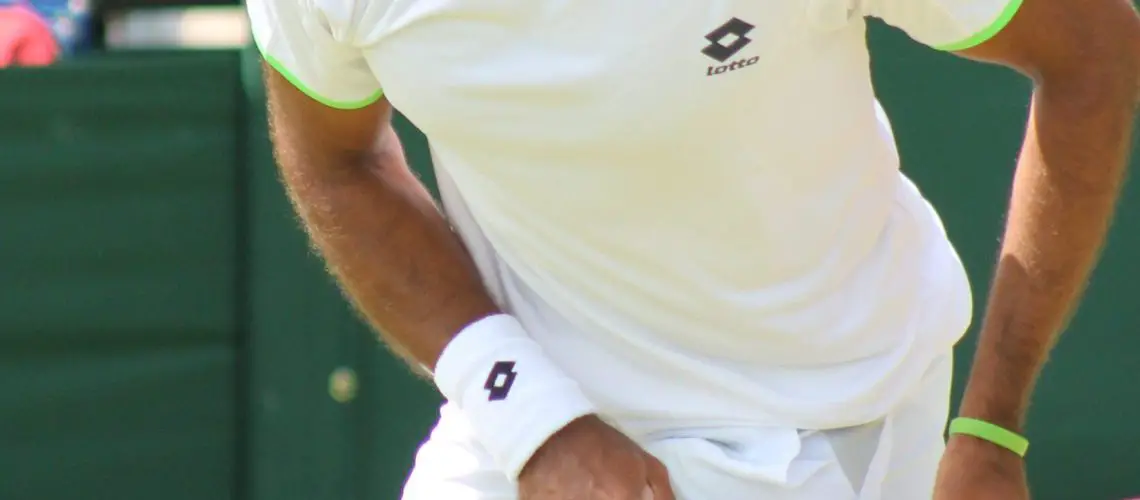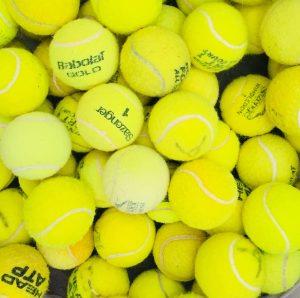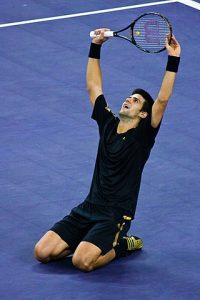We may earn money or products from the companies mentioned in this post.
What is a volley in tennis?

In the dynamic sport of tennis, a volley is an essential shot that requires quick reflexes and precise timing It is a technique where the player hits the ball before it bounces on their side of the court This shot can be executed both at the net or further back in the court, depending on the situation
Characteristics of the shot
A well-executed volley exhibits certain characteristics that set it apart from other shots in tennis Firstly, it requires exceptional hand-eye coordination as players often have to react instinctively to return fast-paced shots Secondly, volleys are predominantly played with a compact swing motion, allowing for better control and placement Lastly, this shot demands an assertive approach, as players must move forward towards the net to take advantage of its effectiveness
How it differs from other shots in tennis
The volley stands out from other shots in tennis due to its unique nature and purpose Unlike groundstrokes or serves that involve hitting the ball after it bounces, volleys require players to intercept the ball mid-air without letting it touch the ground This distinguishes volleys as more aggressive shots that can put pressure on opponents by taking away precious reaction time
Historical background and evolution of the volley

The history of volleys dates back to early days when tennis was first played In those times, serve-and-volley tactics were commonly employed by players who would rush towards the net after serving to quickly finish points at close range
Early days of tennis: serve-and-volley technique
In traditional grass-court tournaments like Wimbledon during the late 19th century and early 20th century, serve-and-volley was considered a dominant playing style The grass surface facilitated fast and low-bouncing shots, making it advantageous for players to approach the net after a powerful serve Legends like Bill Tilden and John McEnroe were known for their exceptional volleying skills, dominating the game with their aggressive net play
Changes in playing styles over the years
As tennis evolved and different surfaces were introduced, playing styles began to shift With slower surfaces like clay and hard courts becoming more prevalent, baseline rallies became more common Players started favoring groundstrokes over volleys due to the increased time available to react and construct points from the back of the court However, despite this shift in strategy, volleys still hold a significant place in modern tennis as they remain an essential weapon in a player’s arsenal
Execution and Technique of a Successful Volley

The key to executing a successful volley lies in the proper stance and body positioning By mastering these foundational elements, tennis players can greatly improve their ability to control the ball and dictate the pace of the game
Proper Stance and Body Positioning for a Volley
1 Split Step Technique: Anticipating the Opponent’s Move
The split step technique is an essential skill that allows players to anticipate their opponent’s shot while maintaining balance and agility Before your opponent makes contact with the ball, perform a small jump or hop, landing with your feet shoulder-width apart This split step prepares you to react quickly in any direction, enabling you to move swiftly towards the net
2 Positioning at the Net: Maintaining Balance and Focus
When approaching the net for a volley, it is crucial to maintain balance and focus on your positioning Keep your weight slightly forward on the balls of your feet, ready to pounce on any incoming shots Stay low with bent knees, allowing for quick adjustments in case of unexpected shots from your opponent
Types of Volleys: Forehand, Backhand, and Overhead Smash
1 Forehand Volley Tips and Techniques
- Grip plays a vital role in executing an effective forehand volley Use an Eastern or Semi-Western grip for optimal control and maneuverability
- Footwork is equally important; take small steps towards the ball while maintaining a balanced position
- Ensure that your swing path is compact and straight, extending towards your target with minimal backswing
- Common mistakes to avoid include excessive wrist movement and not following through with the shot
2 Backhand Volley Tips and Techniques
- When it comes to backhand volleys, players have the option of utilizing a one-handed or two-handed grip, depending on their preference and comfort
- For a one-handed backhand volley, keep your non-dominant hand on the racket for stability and control
- Differences in grip, swing path, and follow-through between the one-handed and two-handed backhands should be considered when executing this shot
3 Overhead Smash Tips and Techniques
- An overhead smash is a powerful shot that can be executed when an opponent hits a high ball within reach
- To execute an effective overhead smash, recognize opportunities where you have ample time to position yourself correctly under the ball
- Footwork is crucial in positioning yourself for an optimal contact point above your head
- Preparation involves turning your body sideways while raising the racket above your head for maximum power and control upon contact with the ball
- Aim for a clean contact point slightly in front of your body, ensuring proper timing for a powerful smash
By mastering these techniques, tennis players can enhance their volley skills and gain an edge over their opponents Practice diligently, focusing on proper stance, footwork, grip, swing path, and follow-through Incorporating these tips into your game will undoubtedly improve your overall performance at the net
The Importance of Volleys in Modern Tennis Strategy

When it comes to modern tennis strategy, incorporating volleys into your game plan can give you a significant advantage on the court Not only do volleys allow you to shorten points, but they also force opponents out of their comfort zone and keep them guessing about your next move
Advantages of Incorporating Volleys Into Your Game Plan
1 Shortening Points: One of the key advantages of using volleys is the ability to shorten points Whether you’re serving or returning, a well-executed volley can help you finish the point quickly and efficiently By minimizing the number of shots required to win a point, you’ll conserve energy and increase your chances of success
2 Forcing Opponents Out of Their Comfort Zone: When you take control at the net with volleys, you dictate play and put pressure on your opponents Many players feel less comfortable playing close to the net, so by consistently approaching and executing volleys effectively, you can disrupt their rhythm and force them into making errors
Utilizing Volleys as Part of an All-Court Player Approach
Incorporating volleys into your game plan is especially beneficial if you adopt an all-court player approach This style involves mixing up baseline rallies with well-timed approaches to the net By varying your game and introducing different strategies, you keep your opponents guessing and make it more challenging for them to anticipate your next move
In addition to mixing up baseline rallies, combining groundstrokes with touch volleys adds another layer of complexity to your game The ability to seamlessly transition from powerful groundstrokes to delicate touch volleys allows for maximum effectiveness on both offensive and defensive plays
Frequently Asked Questions (FAQs)

How do I improve my reaction time when volleying?
Are you looking to enhance your reflexes and anticipation at the net? Improving your reaction time when volleying can greatly enhance your performance on the court Here are a few tips to help you achieve faster reflexes:
- Stay on your toes: Being light on your feet and ready to move will allow you to react quickly to incoming shots
- Anticipate the opponent’s shot: By studying your opponent’s body language and watching their racket, you can start moving towards the anticipated direction of their shot before it even leaves their racket
- Practice drills with a partner: Engaging in drills that involve quick exchanges at the net will challenge your reflexes and train them to become faster over time
Is it better to play with a one-handed or two-handed backhand volley?
The choice between using a one-handed or two-handed backhand volley ultimately depends on personal preference and playing style Let’s explore the pros and cons of each technique:
One-Handed Backhand Volley:
Pros:
Offers greater reach, flexibility, and touch, allowing for more finesse shots at the net It also allows for easier transition into overhead smashes
Cons:
Requires more wrist strength and control compared to a two-handed grip It may take longer to master than its counterpart
Two-Handed Backhand Volley:
Pros:
Provides added stability due to the use of both hands, making it easier to control powerful shots It can be an effective choice for players with less wrist strength
Cons:
Limited reach and flexibility compared to the one-handed backhand volley It may also restrict certain shot options, such as overhead smashes
How can I practice volleys when playing alone or without a partner?
Practicing volleys without a partner might seem challenging, but there are solo training drills and exercises you can try to improve your volley skills:
- Wall drills: Find a sturdy wall and practice hitting volleys against it at varying heights This will help you work on your timing, accuracy, and reflexes
- Cone drills: Set up cones or markers on the ground at different distances from you Practice moving quickly between the cones while simulating volleys with your racket This drill improves footwork and agility
- Tennis ball machine: If available, use a tennis ball machine set to deliver volleys This allows you to practice receiving shots at different speeds and angles
What is the best racquet for a serve-and-volley player?
Choosing the right racquet is crucial for a serve-and-volley player, as it can significantly impact your performance on the court Here are some racquet specifications and features to consider:
Head size:
A smaller head size (around 95-100 square inches) provides better control over shots, allowing for more precision at the net
Weight:
Opt for a slightly heavier racquet (11-12 ounces) that offers stability during powerful serves and volleys
String pattern:
A denser string pattern (18×20 or 16×19) will give you better control, while a looser pattern (16×18 or 16×20) can provide more spin and forgiveness on off-center shots
Balance:
Look for a racquet with a slightly head-light balance, as it allows for quicker maneuverability at the net
Remember, finding the perfect racquet is subjective, so experiment with different options to see what feels comfortable and enhances your serve-and-volley game
Useful Links

How to Hit a Strong Volley in Tennis: Strategies and Tips
How to Volley in Tennis | Tennis Volley Drills
7 Volley Types You Must Know To Master Your Net Game
Ultimate Tennis Volley Guide – Tennis Nation Racquet Sports
How To Volley Your Best In Tennis
video tips, drills, & common mistakes how to volley in tennis
How to Do a Volley in Tennis – wikiHow Fitness
Tennis volley shot – Tennis – essential skills and techniques
How To Hit A Tennis Volley
What Is A Tennis Volley
How to Hit the Half Volley in Tennis (Simple Guide)
The Secrets of Volley Technique
Physical Education – Volley Tennis
What’s a Tennis Volley Shot & How Do I Hit One?
Punch the Volley?
Tips From the Tennis Pro: The Tennis Volley
Tennis Volley Technique
Volley | Tennis Clash Wiki – Fandom






